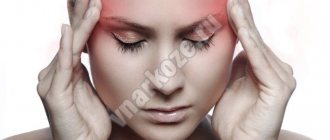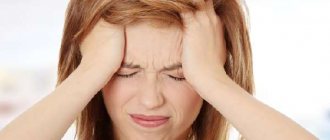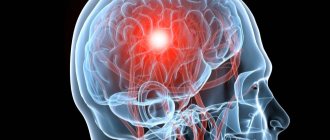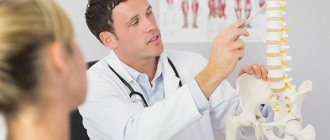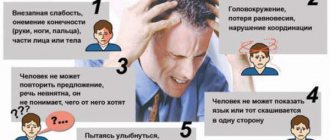Stroke is one of the most severe brain accidents caused by acute cerebrovascular accident. The consequences of a stroke will be felt throughout the rest of your life. Headache is one such consequence.
The intensity of the pain attacks can be so strong that the person may faint. Dizziness, a feeling of heaviness in the head, involuntary bowel movements during loss of consciousness are not the most pleasant side effects of headaches.
Why does my head hurt after a stroke?
A stroke first causes pain at the moment of a brain stroke. Its nature and intensity largely depend on the type of disease (hemorrhagic stroke, ischemic stroke).
Then, after emergency medical care and hospital treatment, the headache can return at any time, but the most dangerous are 3 months after a brain accident. Factors that provoke the development of headaches after a stroke include:
- female gender: due to the structural features of the blood vessels of the brain;
- young age;
- attacks of headache or migraine that bothered the patient before the stroke;
- vascular damage to the cerebellum: in this case, prolonged headaches bother more than 90% of patients;
- hypotension: low baseline blood pressure (less than 120/70 mmHg).
Headaches during a stroke are caused not only by impaired brain function caused by a vascular accident, but also by significant hypoxia - a decrease in the supply of oxygen to nerve cells. The stronger the consequences of a stroke, the longer patients are bothered by this symptom. Over time, during rehabilitation measures, the pain may completely disappear.
Psychogenic causes of pain
Often after suffering a brain catastrophe, patients feel lost. Against the background of residual neurological symptoms and headaches, which can be so severe that they interfere with normal sleep and rest, patients face depression.
Emotional distress further aggravates the condition, and the dull aching pain can become unbearable. It can last for decades and is poorly controlled by taking painkillers.
Pain as a side effect
| Ischemic stroke | Hemorrhagic stroke | Subarachnoid hemorrhage | |
| Onset of the disease | Gradually, over several hours | Acute | Acute |
| Nature of the headache | Moderate, pressing or pressing | Intense, sudden | Sudden, Very intense, patients compare it to “a blow to the head with a sledgehammer” |
| Associated symptoms | Sensory and motor disorders in the arms and legs, impaired speech and mental activity | Loss of consciousness, paralysis of limbs | Loss of consciousness, positive meningeal symptoms, nausea and vomiting |
Headaches during a stroke are caused not only by impaired brain function caused by a vascular accident, but also by significant hypoxia—a decrease in the supply of oxygen to nerve cells. The stronger the consequences of a stroke, the longer patients are bothered by this symptom. Over time, during rehabilitation measures, the pain may completely disappear.
Those at risk for headaches include:
- women;
- young people;
- patients with a history of migraine;
- people with low blood pressure.
Stress
Imagine: your brain has not yet fully recovered from the shock, but you are already fully loading it with new experiences, trying to return your exhausted body to its usual mode as soon as possible... Not everyone can withstand such a load.
In addition to the stress of rehabilitation, depression and fear of not fully recovering can manifest themselves - believe me, if you were able to cope with this condition, then you are lucky, because not all patients are able to escape from dark thoughts.
In any case, if the cause of the headache is stress, this is determined by conducting special neuropsychological tests.
Don't withdraw into yourself after an attack. Talk to friends as often as possible, plan how you will return to normal life after rehabilitation. Let everyone know that you are not ready to just give up, and, importantly, try to believe it yourself.
Headache during a stroke will most often be observed in the victim as a consequence of a blood circulation disorder.
Stress
Imagine: your brain has not yet fully recovered from the shock, but you are already fully loading it with new experiences, trying to return your exhausted body to its usual mode as soon as possible... Not everyone can withstand such a load.
In addition to the stress of rehabilitation, depression and fear of not fully recovering can manifest themselves - believe me, if you were able to cope with this condition, then you are lucky, because not all patients are able to escape from dark thoughts.
In any case, if the cause of the headache is stress, this is determined by conducting special neuropsychological tests.
Don't withdraw into yourself after an attack. Talk to friends as often as possible, plan how you will return to normal life after rehabilitation. Let everyone know that you are not ready to just give up, and, importantly, try to believe it yourself.
More than half of people after a stroke complain of prolonged headaches. Neurologists explain this syndrome as completely natural consequences of a vascular accident. Drug treatment can help you quickly manage pain, recover from a stroke, and prevent relapses. However, there are several reasons why the headache continues for a long time.
Causes of headaches after a stroke
Often after a stroke, the patient experiences ailments reminiscent of migraine attacks. This happens even among those people who were not familiar with this problem before.
Headache after stroke #8211; This is the complaint most often heard by cardiology department doctors who work with stroke patients. Indeed, headaches are an inevitable consequence of such an illness, as are dizziness and noise.
The frequency of headache attacks is individual for everyone: some begin to experience severe pain on a constant basis, while others practically do not feel such a symptom.
Doctors strongly recommend not to leave such a symptom unattended and not to ignore it, since pain in the head is a consequence of poor functioning and condition of the blood vessels of the brain. Ignoring such a problem can lead to a recurrence of the stroke, and then to death, the likelihood of which increases many times over with a second stroke.
One of the most common syndromes encountered in medical practice is severe headache, accompanied by many side symptoms due to sinusitis or other diseases. Typically, the causes of pain lie in circulatory disorders due to the fact that the vessels through which blood flows to the brain are pinched or have areas susceptible to dysfunction.
In this case, it is clear that you need to treat a headache not with analgesics, but by eliminating the causes: ordinary tablets like Analgin will cope with their task for about 30 minutes, but even the anesthetics used to carry out the treatment will not help relieve the sensation for a long time.
According to statistics, every third person on Earth suffers from problems of this nature: very severe headaches are observed in 25% of people at least once a year.
Treatment
How to treat headaches?
Therapy after a stroke should be comprehensive and aimed at eliminating the causes of pain and their relief.
Complex treatment includes drug therapy, auxiliary folk recipes (optional and only after approval by the attending physician), physiotherapeutic procedures, massage, manual and psychotherapy.
Important aspects of successful treatment are maintaining a balanced diet with a high content of folic acid and Omega-3 acids. Carrying out such extensive therapy gives a good chance of a favorable treatment outcome.
Drug treatment
Depending on the causes of the problem, drug treatment includes taking the following drugs:
- Analgesics , non-steroidal anti-inflammatory drugs (NSAIDs) - drugs containing aspirin, analgin and paracetamol; Combined agents give the greatest effect;
- Anticonvulsants - eliminate cephalalgia caused by damage to the central nervous system. Widely used to relieve motor disorders (spasticity) of muscles during the rehabilitation of paralysis. The drugs Finlepsin, Pregabalin and Gabapentin are prescribed;
- Antidepressants - to relieve negative psycho-emotional states and calm the central nervous system. In addition to Sertraline, Fluoxetine and Amitriptyline, it is recommended to use herbal-based drugs as adjuncts;
- Vitamins - vitamin E (tocopherol) helps preserve the vital activity of neurons after an acute cerebral circulatory disorder, and vitamin K prevents bleeding from developing.
The dosage and duration of treatment are selected individually by the attending physician. Typically, the duration of therapy is about 30 days, then a 3-month break is taken.
ethnoscience
Some traditional medicine recipes have proven themselves to be effective in combating headaches:
- A decoction of hawthorn , rose hips and motherwort - take 1 tablespoon of each herb, add 1 liter of boiling water, leave covered for 24 hours, then strain. You need to take this decoction three times a day before meals, 1 glass. The course of treatment is 3 months;
- A mixture of citrus fruits - cut 2 oranges and 2 lemons into medium pieces (along with the zest), remove the seeds and pass through a meat grinder. Add 2 tablespoons of honey to the resulting mass, mix well and let it brew for about a day at room temperature. Take 1 tablespoon daily 3 times a day. Store in the refrigerator in a glass container;
- Hand baths - pour slightly hot water into a basin and lower your hands there for 10 minutes, up to the elbows. If necessary, add boiling water periodically.
Important! Despite their simplicity, traditional recipes are recommended to be used only after the permission of the attending physician.
Healthy lifestyle and diet
Basic drug and physical therapy treatment will be ineffective if you do not adhere to a healthy lifestyle and proper nutrition plan.
It is necessary to completely eliminate all bad habits (alcohol, tobacco); Animal fats, fatty, fried and smoked foods, and sweet pastries are removed from the daily diet. The most complete and accurate nutrition plan will be drawn up by your attending physician or nutritionist.
We invite you to watch a useful video on how to do exercises to prevent headaches:
Painkillers Pills Pain Eliminate Disease Not Treat
Let's consider the types of stroke, because each of them has its own characteristics. Type one is hemorrhagic. The most severe type, in which blood vessels break through and blood flows directly into the brain. Depending on the size of the vessel, its volume can vary from a few to 100 or more milliliters. It is impossible to save a person in this case.
Type two is subarachnoid. In fact, it is a type of hemorrhagic. But the peculiarity of this type is that the blood poured out of the vessels collects in the so-called subarachnoid space of the brain. In this case, intracranial pressure increases, which leads to the development of a dangerous disease - aseptic meningitis.
Many people have some kind of health problem. They constantly live with a feeling of malaise associated with the dysfunction of some organ or part of the body. For such people this is a common state. But if the pain syndrome begins to intensify, then the person immediately strives to find a way out of the current situation. In particular, he starts taking painkillers.
Ancillary drugs
You should also remember about various kinds of auxiliary drugs, for example, complexes of vitamins K and E. This group also includes omega-3 acids and ascorutin with folic acid. The first and last components are found in abundance in simple sea fish, so there is simply no need to purchase additional preparations.
It’s worth talking specifically about aids. Many patients simply forget about them, thinking that they have no significance in therapy. This is not so: the pills that a person takes can trigger processes in his body that will cause him to eventually feel a deficiency of some substance (for example, vitamin E). To replenish what was spent, he needs to adhere to all medical recommendations, including when choosing a diet and additional food additives, even if it seems that the advice of specialists is meaningless. If you wish, you can simply clarify the purpose of prescribing a particular medicine - as a rule, doctors answer these questions clearly and in some detail.
Accompanying signs
In addition to headaches, patients are often bothered by other symptoms. Here are some of them:
- Dizziness, turning into disorientation and inability to coordinate your actions. In such cases, the patient is even prohibited from taking a sitting position.
- Severe nausea, turning into vomiting. Usually it is provoked by dizziness.
- The limbs on one side of the body become numb and paralyzed.
It should be pointed out that, despite its illusory simplicity, the complication of a stroke, in which headaches and loss of orientation appear, is caused by a large number of different reasons, and its treatment can be extremely lengthy and debilitating for the patient. We must remember that this pathology, which includes pain after a stroke and loss of orientation, affects 1/3 of patients.
The main risk groups include:
- women;
- the young age of the patient who is at the rehabilitation stage after a stroke;
- the patient has had severe headaches in the past;
- concentration of the largest number of ruptured vessels in the cerebellum area;
- low blood pressure, which either existed before the stroke or developed subsequently;
- the presence of a previous stroke, and the number of strokes suffered increases the likelihood of the occurrence of this pathology.
Stroke can have many manifestations, which are mainly neurological in origin, but in 5% of cases it is asymptomatic (no signs). This fact always depends on the area of the brain that is damaged.
It is characteristic that the person looks like he is “not himself”, has a drooping corner of his lips and his tongue to one side. Drooling may also spontaneously ooze from the drooping corner of the mouth.
A person who has suffered a stroke has speech disorders - cannot pronounce words correctly; may also complain of visual impairment in one eye and movement disorders of one half of the body.
Complications include not only the aforementioned loss of self-sufficiency, long-term rehabilitation, motor and visual disorders, and impaired thinking and speech. A quarter of patients, despite sufficient medical care, remain disabled.
There are cases of seizures that are not strokes. There is a distinction between migraine and aura, which begins with numbness in the fingertips, then the arm goes numb, and the numbness spreads to the entire half of the body.
The difference with a stroke is that symptoms develop gradually, while a brain attack occurs in a matter of seconds. Migraine with aura can also gradually affect vision.
A person will first see flickering, then partial loss of the visual field. Such symptoms occur because blood flow during migraine decreases gradually starting from the occipital areas of the head, so in migraine with aura visual disturbances dominate.
Don't panic
Thus, there is no need to panic if you have headaches after a stroke. The patient can continue to struggle, and over time, the unpleasant symptom that interferes with normal sleep will be eliminated, and the person will return to a full life, having fully recovered during the rehabilitation process. The most important thing is to strictly follow the doctor’s instructions (from prescribed medications to therapeutic exercises), not to be nervous and not to refuse the support of loved ones - this will make it much easier to get through the difficult period.
“The first signs” of a terrible disease
And now - the most important thing: the symptoms of a stroke that everyone should know about. If you recognize the “first signs” and consult a doctor in a timely manner, you can get out of this condition with minimal physiological and psychological losses. In this case, recovery will take a minimum of time. So, what indicates the onset of a stroke:
- sudden and very severe headache;
- weakness in the limbs (usually on one side);
- a feeling of tingling and numbness in part of the face;
- nausea leading to vomiting;
- loss of balance;
- confusion of thoughts, speech disorders (unclear diction up to “porridge” in the mouth);
- epileptic seizure;
- visual impairment, including blindness.
From “porridge in the mouth” to epilepsy
A stroke is a serious condition in which, as we have already said, the death of brain cells occurs. This process necessarily has consequences, and their range is very wide.
A possible complication depends on the person’s age, as well as his lifestyle, diet and bad habits. The strength of the immune system and the initial condition of the heart and blood vessels play a serious role.
And, of course, the degree of damage to brain cells. Let us dwell on the last, most important point in more detail.
So, the consequences after a cerebral stroke can be different. The severity of the disease primarily depends on the size of the lesion and its location. In addition, timeliness of treatment and quality of rehabilitation play an important role. However, traces of the transferred processes will certainly remain. Here are their consequences.
Prevention
As for the prevention of headaches during ischemic stroke, it usually means preventing the appearance or increase of edema - swelling of the brain by the 3-5th day of the stroke, which is achieved by adequate, carefully substantiated dehydration therapy.
The most effective treatment in this regard is the use of steroid hormones, in particular dexamethasone.
To prevent headaches after a stroke, patients are advised to adhere to a number of requirements:
- constantly monitor blood pressure indicators;
- eliminate the negative impact of stress - stop watching melodramas, listening to sad music, etc.;
- play sports - according to the exercise therapy system, with the permission of the doctor;
- increase physical activity as much as possible;
- undergo massage sessions;
- follow the recommended diet;
- Accurately follow phlebologists’ instructions for taking medications.
As for the prevention of headaches during ischemic stroke, it usually means preventing the appearance or increase of edema - swelling of the brain by the 3-5th day of the stroke, which is achieved by adequate, carefully substantiated dehydration therapy. The most effective treatment in this regard is the use of steroid hormones, in particular dexamethasone.
Diagnostics
Naturally, a specialist will not simply make a diagnosis: first, the patient will need to undergo a whole range of examinations, allowing him to understand what exactly his problem is and how best to get rid of it. Such a complex may include various medical procedures and tests. Here is a list of the most frequent ones:
- Complete blood count, study of the effect of blood sugar concentration on headaches.
- Scanning of blood vessels in the neck.
- Magnetic resonance imaging.
- Echocardiogram of the vessels of the brain, head and heart.
- Measuring blood pressure indicators.
Of course, this is not a complete list - it contains only the most common procedures. The doctor may prescribe other examinations that will help him determine the cause of disorders in the body in a given situation.
So, after a stroke you have a headache, what should you do?
Who is at risk?
What should you avoid after a stroke? First of all, stress, heavy physical activity and poor lifestyle. A person should spend more time in the fresh air, eat healthy food, and stop getting nervous over trifles. However, it is better to be proactive and create conditions under which apoplexy has virtually no chance of success.
As we said above, it is impossible to insure against stroke. However, there is a risk area. So, what factors should every person concerned about their own health pay attention to?
There are several major risk factors for experiencing headaches during or after a stroke.
These factors include:
- women who have had a stroke;
- the young age of the person who will be recovering from a circulatory disorder;
- migraines or a history of a person who has had a stroke;
- an option when the circulatory disorder itself occurs in one of the parts of the cerebellum;
- low blood pressure, or its appearance after a stroke.
Phlebologists identify certain categories of citizens predisposed to the problem:
- female gender - emotional lability and a high level of susceptibility to stress puts patients in first place among other patients;
- age period – the high-risk group includes the population from 30 to 40 years old;
- patients with a history of migraines - this subgroup suffered from outbreaks of headaches before the attack, they experienced an increase in the level of pain.
Post-stroke headaches: why they occur and how to treat them effectively
There are many complications that can result from a stroke, and persistent headache is one of them. The occurrence of transient cephalgia after the development of a cerebral catastrophe is considered a normal variant. The sensations are mild or moderate in severity, last no more than 30 days, and their intensity gradually decreases.
At-risk groups
The course of the post-stroke period is influenced by a number of external and individual factors. The risks of developing cephalalgia are higher in people who have suffered a hemorrhagic stroke.
You can learn more about hemorrhagic stroke here.
A large area affected also increases the likelihood of a problem occurring. Severe pain during the rehabilitation period is almost guaranteed if the posterior cerebral artery or cerebellum is damaged.
Groups of people who most often experience headaches during a stroke:
- women – suffer from the symptom 5 times more often due to weaker immunity, a sensitive endocrine system, and systematic fluctuations in hormonal levels;
- young people under 40 years of age;
- persons with a history of hypotension - disruption of the blood channels provokes cerebral circulatory failure;
- people with weather dependence - sensitivity to weather changes is often due to vascular weakness;
You will learn more about weather dependence and cephalgia from this article.
- Migraine patients are people who are initially predisposed to headaches with reduced immunity and problematic blood vessels.
Pathological cephalgia of the post-stroke period is highly pronounced. It negatively affects the general condition of the patient and does not allow him to fully work in accordance with the rehabilitation program. The problem can cause deep depression, from which it is very difficult to lift patients out of it.
Men at the epicenter of danger
And finally, another risk factor is gender. According to statistics, the risk of developing a stroke among representatives of the stronger half of humanity is approximately 30% higher than among women.
The reasons are obvious: men are more likely than women to lead an unhealthy lifestyle, abuse alcohol and fatty foods, experience failures more difficultly and do not like to go to doctors. Hence another sad statistical fact: their mortality rate from stroke is much higher than that of beautiful ladies.
Features of manifestations in women
Due to physiological characteristics, the signs of an impending stroke in men and women are somewhat different, although the general picture is similar. Warning signs of a possible stroke in a woman:
- severe headaches appear for no apparent reason;
- numbness of the upper and lower limbs on the right or left;
- vision is impaired, and double vision is often observed;
- Nausea, vomiting and hiccups occur periodically;
- facial muscles weaken, signs of numbness are observed;
- gestures and speech are difficult;
- sensitivity to pain and temperature changes is impaired;
- the patient loses consciousness for a short time;
- attacks of severe dizziness occur;
- convulsions appear (not in every case).
In addition, changes occur in the woman’s emotional state; a depressive state is replaced by attacks of irritability for no reason.
Only under the supervision of a doctor!
Brain stroke and consequences are a very serious topic. Recovery takes a long time and should only take place under the supervision of a doctor.
Only he will be able to select the right medications, offer a balanced diet, and refer you to a neurological sanatorium. And there the patient will receive physiotherapy, physical therapy (therapeutic exercise), massage, mud treatment, and acupuncture.
Therefore, the biggest mistake a person can make is to suffer a stroke on their feet.
The problem is that many people feel like they are doing great and are relatively unscathed. In fact, apoplexy is a very insidious disease that can return in the form of a second stroke. And, unfortunately, it is he who is most often the last for a person. So you shouldn't risk your life against common sense.
Causes of post-stroke pain
At present, the mechanism of the appearance of pain in the head in a person who has suffered a stroke is still not fully understood. However, most often the reasons for their appearance may be:
- cerebral edema;
- impaired blood flow through the veins;
- problems with reflex processes provoked by a vascular accident;
- difficulty in oxygen metabolism in brain tissue;
- pain of tension arising from an uncomfortable position in bed in bedridden patients;
- changes in weather conditions, almost all people who have suffered a stroke react sharply to changes in weather conditions;
- heavy load during rehabilitation procedures;
- reaction to medications;
- depression;
- pain not related to the disease, which is independent, newly acquired.

